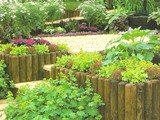|
Planting a Garden IdeasPlanting a garden is a very easy task once accompanied by proper planning. The planning part of growing a garden can be fun and exciting as that’s where you can implement your creative skills. Now, the first thing I always recommend doing when planting a garden is to make some notes. I like to call it garden record keeping. Vegetable Garden PlanningWhen starting your first garden it may be the hardest one to plan because everything is theoretical. If you’re planning subsequent gardens, you can stick to the plan you used in the previous year. You can do this while making changes based on your learning experiences. Get your hands on a big calendar with a lot of space for writing to make your weekly notes. Continue to make your records during the summer as well as during the planting and harvesting months. It’s best to not wait until winter to think about what you have learned from the previous summer because you may not remember an important note for the following year. What you can do is to construct a preliminary plan for your next year’s garden every fall while the present growing season is still fresh in your head. Keeping records of your garden can offer you some valuable lessons, trust me. You’ll tend to discover in garden planting that 2 gardening years are not similar. This is due to changes in weather conditions and pest populations. Even your choice with regards to what you want to grow will vary. After about 2 or 3 seasons, you will begin to notice some trends and as time progresses, you’ll be able to better understand the conditions in your garden. Here’s a Vegetable Garden Record Outline1. Names of varieties planted 2. The amount of seeds used and how much garden space you were able to plant with them. 3. Any setbacks or problems such as vegetable garden pests, insects, plant diseases, bad weather conditions. 4. The time you began to harvest 5. Each crop yield 6. Changes to be made Small Garden Ideas to Consider When Planting a GardenYou can make use of semi-shaded areas that are not appropriate for planting tomatoes, squash or melons by growing some green leafy vegetables. Some good examples are lettuce, chard or mustard greens. Mustard greens and lettuce are my favorite green vegetables.  Why not make some room for herbs. Herbs tend to create a really beautiful variety of flavors within a limited growing space. Varieties that are Ideal for PlantingIt’s best to avoid sprawling varieties. Try planting 6 rows of carrots or onions in the same square footage and you can even add a row of some squash vines to accompany them. Opt for the compact varieties, “bush” varieties when growing cucumbers, melons and pumpkins. Fast maturing vegetables can be added in the space between the slower maturing ones that will spread eventually. For example, you can plant lettuce or radishes between the vine plants of squash or pumpkin for a quick crop before the plants nearby need the space. Choose Vegetables that Bear ContinuouslyGive preference to vegetables that bear on a continuous basis. You can continue to harvest your chard during the growing season way after the spinach has gone to seed with the beginning of hot weather. Some excellent examples of continuously bearing crops are…

Double CroppingThis method of planting can provide you with the best productivity per square foot. When you plant another crop right after you’ve harvested the previous one, double cropping keeps your garden in good consistent production. It’s most effective with a long growing season however, in most areas lettuce, beets and carrots mature quickly enough so that you’ll have time for a second crop. This is provided if you plant the second crop as soon as the first one is harvested. Maximizing your Garden’s ProductionHarvest on a daily basis to stimulate your garden’s production. There are a lot of vegetable plants such as broccoli, cucumbers, beans and summer squash that will stop producing if the plants aren’t kept picked. Arrange your vegetable garden to grow up rather than out by capitalizing on some vertical growing space. You can train vines on supports to free up the space at their feet for the other crops. Some tall crops such as corn will fit very well on the north end of your garden so that they won’t shade the other plants. Deep watering will allow the roots to go down instead of spreading sideways. This will make it easier for you to space your plants closer together. These are some good ideas that you can implement to get the most out of planting a garden. They are worth the try even if you’re planting a garden that’s small, simple and unique.
|









